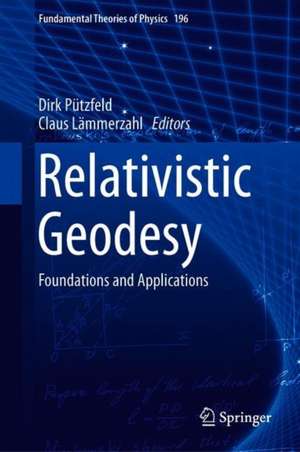Relativistic Geodesy: Foundations and Applications: Fundamental Theories of Physics, cartea 196
Editat de Dirk Puetzfeld, Claus Lämmerzahlen Limba Engleză Hardback – 19 feb 2019
Emphasis is placed on geodetically relevant definitions and fundamental methods in the context of Einstein’s theory (e.g. the role of observers, use of clocks, definition of reference systems and the geoid, use of relativistic approximation schemes). Further, the applications discussed range from chronometric and gradiometric determinations of the gravitational field, to the latest (satellite) experiments. The impact of choices made at a fundamental theoretical level on the interpretation of measurements and the planning of future experiments is also highlighted. Providing an up-to-the-minute status report on the respective topics discussed, the book will not only benefit experts, but will also serve as a guide for students with a background in either geodesy or gravitational physics who are interested in entering and exploring this emerging field.
Din seria Fundamental Theories of Physics
- 20%
 Preț: 1002.37 lei
Preț: 1002.37 lei -
 Preț: 426.56 lei
Preț: 426.56 lei - 20%
 Preț: 819.48 lei
Preț: 819.48 lei - 18%
 Preț: 779.26 lei
Preț: 779.26 lei - 18%
 Preț: 955.25 lei
Preț: 955.25 lei - 18%
 Preț: 950.52 lei
Preț: 950.52 lei - 24%
 Preț: 794.89 lei
Preț: 794.89 lei - 18%
 Preț: 948.47 lei
Preț: 948.47 lei - 15%
 Preț: 589.80 lei
Preț: 589.80 lei - 18%
 Preț: 1229.73 lei
Preț: 1229.73 lei - 15%
 Preț: 587.83 lei
Preț: 587.83 lei - 18%
 Preț: 1236.06 lei
Preț: 1236.06 lei - 18%
 Preț: 946.87 lei
Preț: 946.87 lei -
 Preț: 394.87 lei
Preț: 394.87 lei - 18%
 Preț: 954.93 lei
Preț: 954.93 lei - 18%
 Preț: 1241.10 lei
Preț: 1241.10 lei - 18%
 Preț: 954.93 lei
Preț: 954.93 lei - 18%
 Preț: 953.35 lei
Preț: 953.35 lei - 18%
 Preț: 948.92 lei
Preț: 948.92 lei - 15%
 Preț: 648.05 lei
Preț: 648.05 lei - 18%
 Preț: 1232.09 lei
Preț: 1232.09 lei - 18%
 Preț: 996.78 lei
Preț: 996.78 lei - 18%
 Preț: 946.41 lei
Preț: 946.41 lei - 15%
 Preț: 640.24 lei
Preț: 640.24 lei - 15%
 Preț: 636.80 lei
Preț: 636.80 lei -
 Preț: 391.79 lei
Preț: 391.79 lei - 18%
 Preț: 780.19 lei
Preț: 780.19 lei -
 Preț: 391.79 lei
Preț: 391.79 lei - 15%
 Preț: 649.06 lei
Preț: 649.06 lei -
 Preț: 397.76 lei
Preț: 397.76 lei - 24%
 Preț: 586.69 lei
Preț: 586.69 lei - 15%
 Preț: 644.95 lei
Preț: 644.95 lei - 18%
 Preț: 1228.15 lei
Preț: 1228.15 lei
Preț: 796.76 lei
Preț vechi: 971.66 lei
-18% Nou
Puncte Express: 1195
Preț estimativ în valută:
152.47€ • 159.71$ • 126.36£
152.47€ • 159.71$ • 126.36£
Carte tipărită la comandă
Livrare economică 08-22 aprilie
Preluare comenzi: 021 569.72.76
Specificații
ISBN-13: 9783030114992
ISBN-10: 3030114996
Pagini: 575
Ilustrații: XIII, 479 p. 115 illus., 51 illus. in color.
Dimensiuni: 155 x 235 mm
Greutate: 0.87 kg
Ediția:1st ed. 2019
Editura: Springer International Publishing
Colecția Springer
Seria Fundamental Theories of Physics
Locul publicării:Cham, Switzerland
ISBN-10: 3030114996
Pagini: 575
Ilustrații: XIII, 479 p. 115 illus., 51 illus. in color.
Dimensiuni: 155 x 235 mm
Greutate: 0.87 kg
Ediția:1st ed. 2019
Editura: Springer International Publishing
Colecția Springer
Seria Fundamental Theories of Physics
Locul publicării:Cham, Switzerland
Cuprins
Introduction.- Time and frequency metrology in the context of relativistic geodesy.- Chronometric geodesy: methods and applications.- Measuring the gravitational field in General Relativity: From deviation equations and the gravitational compass to relativistic clock gradiometry.- A Snapshot of J. L. Synge.- General Relativistic Gravity Gradiometry.- Reference-ellipsoid and normal gravity field in post-Newtonian geodesy.- Anholonomity in Pre and Relativistic Geodesy.- Epistemic relativity: An experimental approach to physics.- Use of geodesy and geophysics measurements to probe the gravitational interaction.- Operationalization of basic relativistic measurements.- Can spacetime curvature be used in future navigation systems?.- World-line perturbation theory.- On the applicability of the geodesic deviation equation in General Relativity.- Measurement of frame dragging with geodetic satellites based on gravity field models from CHAMP, GRACE and beyond.- Tests of General Relativity with the LARES Satellites.
Recenzii
“This volume surveys a broad range of topics in modern geodesy where relativistic effects are important. … Readers with the appropriate background and interests will find much to learn from this volume.” (Jonathan Thornburg, The Observatory, Vol. 139 (1273), December, 2019)
Textul de pe ultima copertă
Due to steadily improving experimental accuracy, relativistic concepts – based on Einstein’s theory of Special and General Relativity – are playing an increasingly important role in modern geodesy. This book offers an introduction to the emerging field of relativistic geodesy, and covers topics ranging from the description of clocks and test bodies, to time and frequency measurements, to current and future observations.
Emphasis is placed on geodetically relevant definitions and fundamental methods in the context of Einstein’s theory (e.g. the role of observers, use of clocks, definition of reference systems and the geoid, use of relativistic approximation schemes). Further, the applications discussed range from chronometric and gradiometric determinations of the gravitational field, to the latest (satellite) experiments. The impact of choices made at a fundamental theoretical level on the interpretation of measurements and the planning of future experiments is alsohighlighted. Providing an up-to-the-minute status report on the respective topics discussed, the book will not only benefit experts, but will also serve as a guide for students with a background in either geodesy or gravitational physics who are interested in entering and exploring this emerging field.
Caracteristici
Up-to-date introduction and overview of current research Balanced mix of theoretical and observational contributions? Highlights the impact of choices at a fundamental theoretical level on the interpretation of measurements and the planning of future experiments
